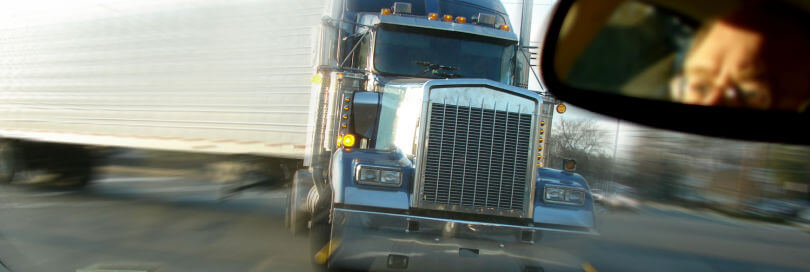
Sharing the road with 18-wheelers and other commercial vehicles can be intimidating. These massive trucks can weigh up to 80,000 pounds, which means an accident with a semi could easily destroy a car and leave occupants with severe or even fatal injuries.
Huge blind spots are one of the factors that make trucks so dangerous on Alabama roads. When truck drivers are careless and fail to monitor the traffic around them, they could easily collide with a nearby vehicle.
If you were injured in a blind spot accident with a truck, contact the law firm of Morris, King & Hodge, P.C., about your next steps. Our experienced truck blind spot accident lawyers in Huntsville have been helping injury victims since 1966, and we’ve earned the highest possible ranking of “AV” from Martindale-Hubbell. We’re dedicated to providing effective and qualified legal services to every client.
We offer a free case review to answer your questions and help you make the right choice for moving forward. Contact us today for your free consultation.
What Are Blind Spots?
Semi-truck blind spots are areas around a truck where the truck driver cannot easily see. These blind spots may vary depending on a truck’s height, length, and mirror placement, but they are generally extensive. Since the driver cannot see what’s in their blind spots, they may not know when another vehicle is nearby.
Where Are the Blind Spots Around a Truck?
Commercial trucks have blind spots on every side of the vehicle. According to the Federal Motor Carrier Safety Administration, there are massive areas around a truck that drivers may not be able to see. Common blind spot locations include:
- In the front – Drivers may not be able to see the space right in front of the truck. That means that when a truck is following a car too closely, the truck driver may not see it.
- On the left side – The blind spot on the left, or the driver’s side of the truck, can be large and can extend from the driver past the truck’s trailer hitch. If you’re passing a truck, make sure you get out of this blind spot as soon as you can.
- On the right side – The blind spot on the right side of the truck is one of the largest. It extends diagonally from the right-side mirror back and two lanes to the right of the truck. Since this blind spot is so large, it’s never safe to pass a truck on the right.
- In the back – The space directly behind a commercial truck’s trailer is usually not visible to drivers. If you’re immediately behind a truck and you can’t see a truck’s mirrors, then it’s likely the driver can’t see you.
Causes of Blind Spot Crashes in Huntsville
In some cases, truck drivers fail to live up to the standards they’re supposed to follow. Truckers may cause blind spot accidents in Huntsville by:
- Failing to check blind spots before making a lane change
- Failing to monitor traffic entering blind spots
- Following other vehicles too closely
- Driving aggressively or recklessly
- Driving while distracted
- Relying too much on blind spot detection systems
Drivers of other vehicles may also contribute to truck blind spot accidents by lingering in a truck’s blind spots for too long.
Common Types of Truck Blind Spot Accidents
When a truck driver moves their vehicle into a blind spot, several different types of accidents could occur. The type will depend on the location of the other vehicle, the speed of the vehicle, and how the drivers react. These types of accidents could include:
- Rear-end accidents
- Sideswipe accidents
- Side-impact/T-bone accidents
- Underride accidents
- Rollovers
- Jackknife accidents
Who Is at Fault for a Truck Accident Caused by a Blind Spot?
Either driver could potentially be responsible for a blind spot accident. For example, if the driver of the other vehicle tailgates a truck, they may be responsible for a resulting rear-end accident if traffic suddenly comes to a stop.
However, truck drivers are often responsible for blind spot accidents. Truck drivers need to stay alert, monitor traffic, and check any blind-spot monitoring sensors on their vehicles. If they drive negligently and don’t take the steps they should to keep you safe, then they may be liable for your injuries if they cause a crash.
How Can I Avoid Being in a Truck Blind Spot Crash?
Blindspot accidents can lead to severe injuries and lifelong problems. While truck drivers should do everything they can to watch out for you, you can take essential steps to minimize your risk of winding up in an accident. These include:
- Avoid following a truck too closely. Trucks have enormous blind spots behind them, and following too closely could result in an accident.
- Give trucks plenty of room when moving into the lane in front of them. Drivers can’t see what’s immediately in front of their truck, so stay out of their blind spot and only move in front of them only when you can give them enough room.
- Don’t linger in blind spots. If you need to pass a truck, move through their blind spot quickly.
- Avoid passing on the right. A truck’s largest blind spot is on the right, so never take a chance by passing on that side.
- Report dangerous truck drivers. If you encounter a dangerous truck driver, you can report them to the Federal Motor Carrier Safety Administration.
Huntsville Blind Spot Accident Statistics
According to the Alabama Department of Transportation, in just one recent year, nearly 1,600 crashes involving trucks were caused by improper lane changes or use, and almost 900 were caused by unseen objects, persons, or vehicles. Blindspot accidents happen all the time on Huntsville and Alabama roads, so be aware of the trucks around you and how their blind spots could hurt you.
Contact Our Experienced Huntsville Truck Accident Lawyers Today
If you’ve been injured in a truck accident on Huntsville roads, contact Morris, King & Hodge, P.C., now. As a full-service Huntsville firm with a proven track record of results, we’re ready to handle your blind spot accident case. With experience fighting for our clients in courts throughout Huntsville and North Alabama, we know what it takes to build the solid accident claim you need.
Contact us 24/7 for your free case review. There’s no cost and no further obligations. We’re prepared to show you how we can help you move forward.









